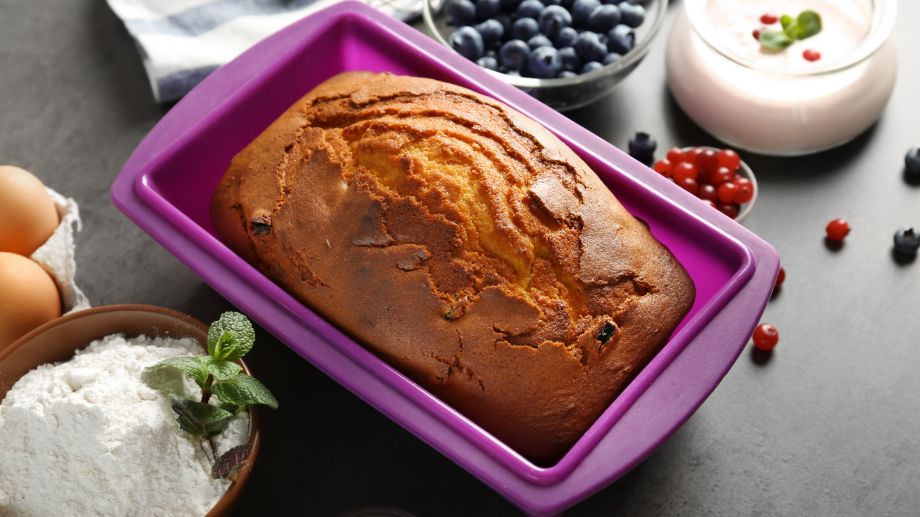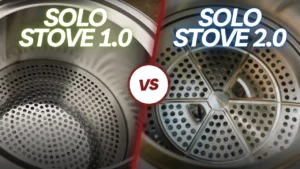If you’re purchasing some new bakeware, an essential element of your decision must be the material of the cookie sheets and cake pans. Silicone baking trays are becoming more common and have some advantages but does the material of the pan have an impact on baking?
Which material cooks faster, silicone or metal?
Baking times are generally 5-15 minutes longer for silicone baking trays compared to metal. Silicone doesn't conduct heat as well as metal so it cooks slightly slower. However, silicone pans are less likely to burn your food like metal pans can do.
Both metal and silicone bakeware have their pros and cons and which type you decide is up to you. But it's important to know how the material acts in the oven so you can make time and temperature adjustments.
Let’s look at the differences in baking times for silicone and metal pans.
Does It Take Longer To Bake In Silicone Compared To Metal?
It takes slightly longer to bake in silicone pans than in metal pans, but usually only around 5 to 15 minutes longer (if that).
The pan’s ability to conduct heat impacts the baking time, temperature, and browning of the batter.
Traditionally, baking pans and cookie sheets were all made of metal because it doesn't melt at high temperatures and won't impart bad flavors or chemicals into your food. It is also an effective conductor of heat, so it heats quickly and consistently – allowing your food to cook from all directions.
Silicone, which is a type of rubber, is a newer invention and has only really become a popular bakeware option in the last 10-20 years. There is the benefit of not needing to grease silicone baking trays like you do with metal ones and silicone is inert up to very high temperatures so is safe to cook with in the over.
Silicone does not transfer heat as quickly because it is an insulator rather than a conductor. Poor heat conductivity means silicone pans take longer to heat up but then bake evenly and slowly.
Slower baking is advantageous at times because your bakes are less likely to burn and dry out. However, your cookies might not turn a tasty golden brown as easily if that's what you're going for.
Baking an item at the same temperature and for the same time as you would in a metal pan might create a different result. So it's important to adjust accordingly and be aware of this so your items aren't over or under cooked.
Let’s look at the baking time differences for various bakes.
Cake Baking Time: Silicone Vs. Metal
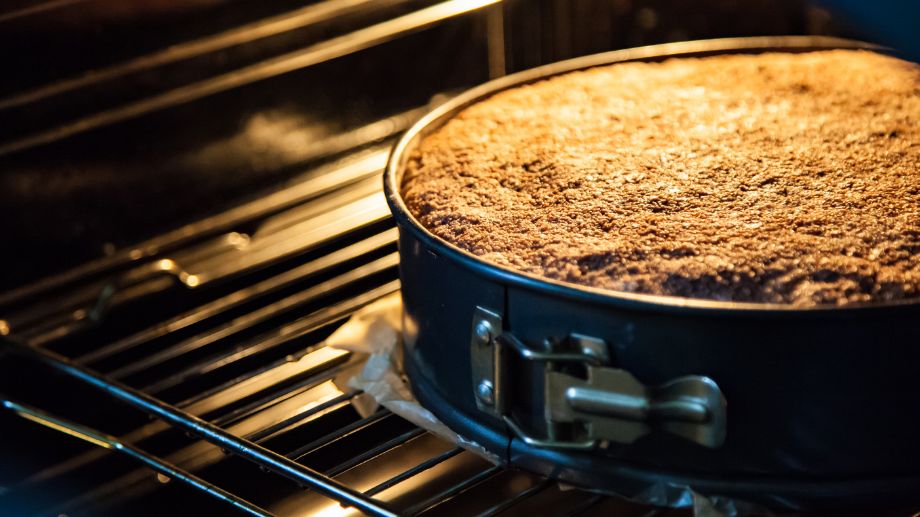
We'll start with the largest items you'll likely be baking and that is cakes.
Silicon cake pans, including delicately patterned bundt pans, sound ideal because the cake won’t stick. Do they stack up against the traditional metal pans in terms of baking time?
Cake Baking Time: Silicone
Cakes take longer to bake in silicone than in metal pans.
Lighter sponge cakes need only 3 to 5 minutes longer than they would in metal pans. These quicker bakes do well in silicone pans, as you don’t need them to brown much. Keep an eye on the pans and test the cake with a skewer as soon as they look done.
However, baking experiments with pound cakes and bundt cakes show that you may need to reduce the temperature and bake for at least 10 to 15 minutes more for heavier batters.
The heat-insulating qualities of silicone mean that these larger cakes take longer to bake. This can sometimes result in the outsides being almost burned by the time the interiors are cooked.
Once you are used to using these pans, reducing the temperature slightly by around 25ºF/10ºC can be helpful.
Cake Baking Time: Metal
Most of us are used to baking cakes in metal pans and most recipes assume you're using a metal pan which means adjustments are rarely necessary.
Metal pans will bake cakes approximately 3-5 minutes faster for lighter sponge cakes and 10-15 minutes faster for heavier batters.
Because metal is a good heat conductor, cakes are heated from all directions as they are in direct contact with the metal. This means they will rise quickly and evenly, producing a delectable golden-brown color on sponges and a rich dark brown for chocolate cakes.
Cupcake/Muffin Baking Time: Silicone Vs Metal
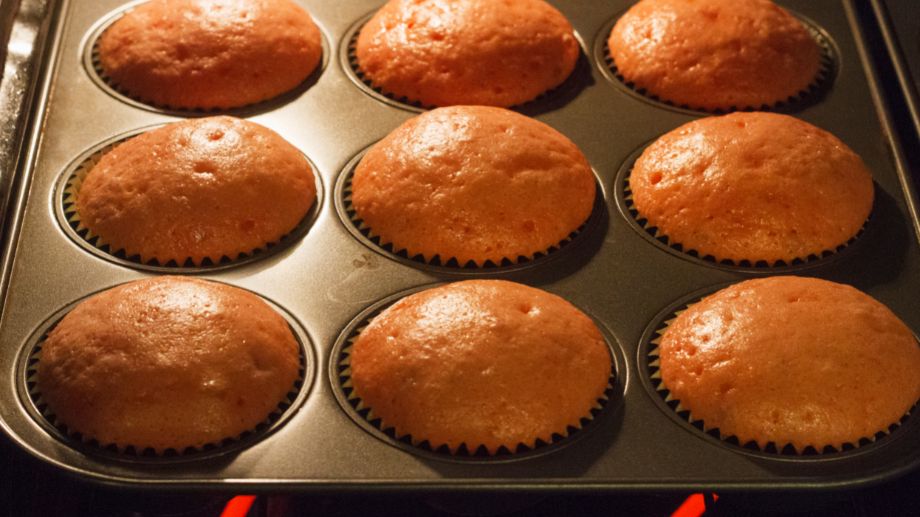
Cupcakes and muffins are favorite family bakes, and everyone looks forward to a tender, spongy cupcake or moist, hearty muffin.
How does silicone cook these smaller bakes compared to metal?
Cupcake/Muffin Baking Time: Silicone
Cupcakes and muffins tend to take 5 to 10 minutes longer to bake in silicone pans compared to metal, with cupcakes baking for approximately 20 minutes and muffins for 30 minutes or so.
Because of how it conducts heat, silicone bakeware will take longer to bake cupcakes and muffins. The bases aren’t exposed to heat for the same length of time as the tops, so you need to add five to ten minutes to the recipe’s cooking time.
This is also true if you use silicone cake patties inside a metal cupcake tray. The silicone will insulate the cupcakes/muffins from the extreme heat of the metal baking tray causing them to cook slightly slower.
The challenge many bakers face with silicone muffin and cupcake pans is that the tops of the bakes are done when the interior and bottoms are undercooked.
If the tops start to dry out, reduce the temperature in your over and bake for slightly longer. Or consider covering them with aluminum foil.
Cupcake/Muffin Baking Time: Metal
Because of metal’s conductivity, regular-size cupcakes will take about 15-20 minutes to bake in a regular oven, while muffins will take 20-25 minutes.
Cupcakes will cook 5-10 minutes faster in metal trays compared to silicone trays.
These baking times will increase or decrease depending on whether you’re baking mini or jumbo cakes and muffins.
Which metal pans you use will also influence cupcakes and muffins’ baking time:
- Aluminum is an excellent and consistent conductor of heat and is perfect for baking. Be guided by the shorter baking time, especially if you have a fan oven.
- If you prefer a non-stick finish, you’ll probably use a stainless-steel pan with a non-stick coating. Your cupcakes and muffins must use the full range of time given as stainless-steel conducts heat more slowly than aluminum. However, the longer baking time will give the baked goods a better lift.
Open Baking Tray Baking Time: Silicone Vs. Metal
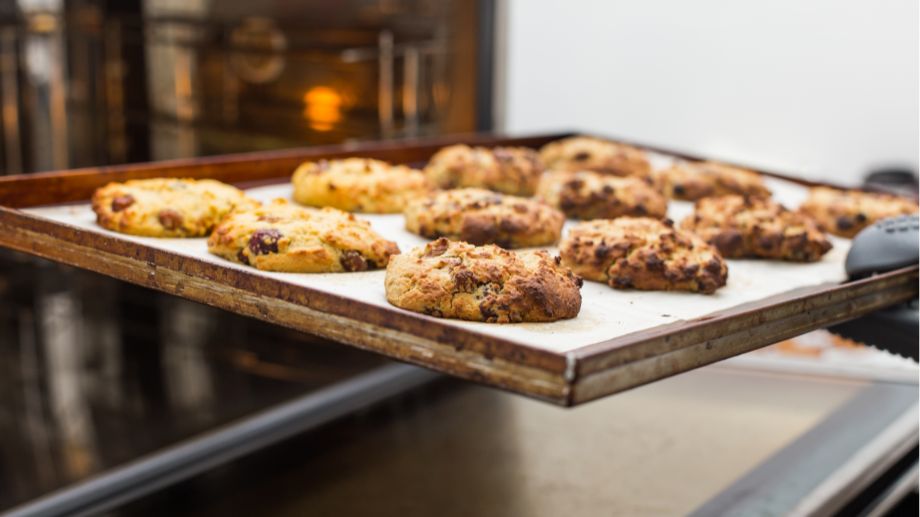
Cookie sheets and baking trays are a kitchen workhouse, baking everything from holiday gingerbread to snickerdoodles or even pizzas. How does silicone’s baking time compare with metal?
Open Baking Tray Baking Time: Silicone
When baking items on open baking trays silicone and metal trays will perform extremely similar. You can usually cook your item for the same amount of time or might need 1-2 minutes longer for silicone baking trays vs metal.
This is because the majority of the food is exposed to the air in the over and the tray doesn't play as big of a role.
However, silicone's slow heat transfer means cookies are other items are less likely to burn from the bottom. Giving you a softer bottom than you would get from a metal baking tray.
Nowadays, silicone trays are often used on top of metal baking trays as a non-stick reusable alternative to baking paper.
Open Baking Tray Baking Time: Metal
Metal baking trays are thin and will heat up extremely quickly in the oven.
Because they conduct heat so well metal baking trays can cook your items from the bottom. If you aren't careful this can lead to burning, which you may not want.
But generally speaking metal baking trays work great and and there is no point replacing them with silicone ones unless you really need to.
When To Use Silicone Over Metal For Baking
Silicone pans and baking sheets are your best bet for baking light cakes, quick bread, and muffins. Their poor heat conductivity means they heat slowly and evenly, with a bit of browning. You should have no problem if you adjust your baking time for a slightly longer, slower bake.
The other enormous advantage of silicone is that it doesn’t stick and is therefore easy to clean.
Read how to keep your silicone kitchenware in good shape: How to clean silicone trays.
When To Use Metal Over Silicone For Baking
Metal pans are always preferable to silicone for cakes, cookies, brownies, loaves, and tarts.
Choose light-colored aluminum pans for browning, effective heating, and consistent baking of brownies, cookies, and tarts.
Although metal pans tend to be stickier, use parchment or baking spray. You can also use a non-stick pan, although these will be less conductive than aluminum.
One of the major benefits of metal bakeware over silicone is that silicone can absorb smells and start to smell funny over time. Metal baking trays don't have this same problem that silicone trays have as they tend to not absorb smells at all and are easy to clean, especially if they come with a non-stick coating.
There is also the danger that some silicone bakeware has plastic fillers which can cause a bad chemical smell and even leach chemicals into your food. However, this doesn't happen with high quality pure silicone bakeware. So make sure you buy a good brand.
Key Takeaways
Silicone is not as effective a conductor of heat as metal, so bakeware takes longer to heat up. When it does heat up, silicone bakes evenly and consistently. What does this mean for baking times?
- It takes longer to bake using silicone bakeware than metal bakeware.
- Add 5-10 minutes to the baking time for cupcakes and muffins. Cover the tops of the bakes with aluminum if they start to brown.
- For small cakes, add 5-10 minutes to the baking time.
- For larger cakes, reduce the temperature by 25⁰ and extend the baking time. Check after 10 minutes.
- For thin cookies, bake only for 5 to 6 minutes.
- For thicker cookies, reduce the temperature by 25⁰and extend the baking time by 10 minutes.
- Silicone bakeware is best for light cakes, muffins, and quick loaves, especially if you want non-stick pans.
- Metal bakeware, especially aluminum, bakes more quickly, effectively, and consistently across all baked goods.

